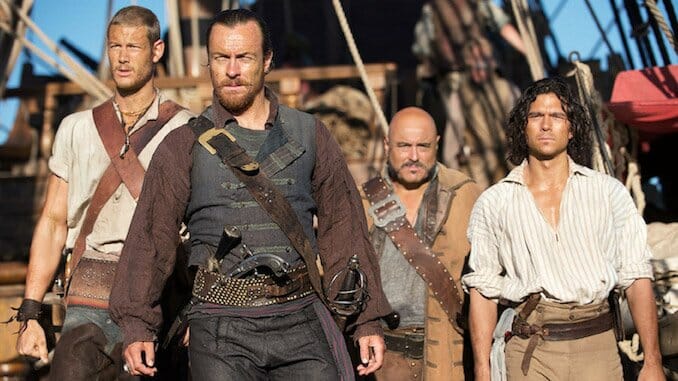TV Rewind: How Black Sails Explored the Power of Legend, Truth, and the Stories We Tell
Photo Courtesy of Starz
Editor’s Note: Welcome to our TV Rewind column! The Paste writers are diving into the streaming catalogue to discuss some of our favorite classic series as well as great shows we’re watching for the first time. Come relive your TV past with us, or discover what should be your next binge watch below:
![]()
The criminally underrated Starz period drama Black Sails is an intriguingly compelling mix of fact and legend, blending the fictional (characters from Robert Louis Stevenson’s classic novel Treasure Island) with the real (Charles Vane, Edward Teach, and the pirate island of Nassau) to create something rich, propulsive and utterly singular. An action-packed pirate series that’s secretly a meditation on the power inherent in the simple act of storytelling may sound surprising, but it probably shouldn’t. After all, pirates are the very people for whom truth is the flimsiest of illusions, and who understand that the way the world remembers you is often more important than who you actually are.
The drama, which premiered in 2014 and ran for four seasons, was like little else on television at the time, mixing executive producer Michael Bay’s singular love of explosions and slow-motion fight sequences with period-appropriate tall ships and a delicate, thoughtful rumination on the power of the stories we leave behind. The series deftly explored ideas of myth and legacy, ground its narrative in a pair of morally gray heroes, and elevated its women and queer characters in a way that few period dramas have attempted to match since.
Ostensibly set about 20 years before the events that take place in Stevenson’s Treasure Island, Black Sails carefully balances the future that we know is coming for several of these characters with the immediacy of the story that’s happening onscreen. And, in doing so, we not only witness the birth of multiple legends in real-time, we learn how valuable the opportunity to craft those tales can be.
When this series begins, the infamous Long John Silver doesn’t exist yet. Instead, there is just John Silver (Luke Arnold), an enterprising con artist and average pirate who talks his way out of certain death and onto the crew of a man named Captain James Flint (Toby Stephens). Minus the peg-leg, parrot, and overtly villainous demeanor, this version of Silver is a reluctant hero in spite of himself, and his journey to becoming the man who will one day serve as Jim Hawkins’ primary antagonist is the subplot that constantly hums in the background of this show.
Here, Flint and his crew are busy hunting a Spanish treasure galleon known as the Urca de Lima, and the fallout from the quest to claim this ship’s enormous cache of gold drives much of the series’ long-term plot. It introduces us to many key characters, including the same Billy Bones (Tom Hopper) who will one day be a drunk curmudgeon in Stevenson’s tale, and real-life figures such as ruthless pirate Charles Vane (Zach McGowan) as well as Black Sails’ Bonnie-and-Clyde-style OTP, Jack Rackham (Toby Schmitz) and Anne Bonny (Clara Paget). Even Blackbeard himself shows up eventually, though the show’s depiction of Edward Teach (Ray Stevenson) also takes some liberties with the real man’s admittedly shoddy historical record.
Over the course of its run, the series explores complex narratives of ambition, greed, and betrayal. It features an array of complicated, ruthless women, all given the sorts of roles that are too often denied to female characters in historical pieces such as this. From Eleanor Guthrie, a woman determined to forge a place for herself in a man’s world, to the perpetually scheming brothel madam Max, who simply desires to maintain her own power at any cost, and the legendary Bonny, who plays down her femininity so that she might be taken more seriously by the men she crews with, these are all female characters who lead refreshingly rich lives.